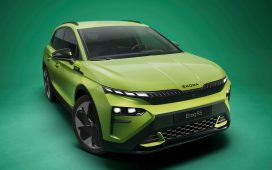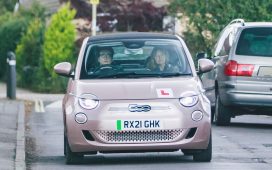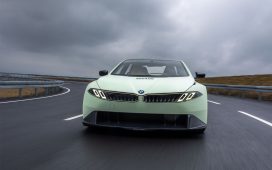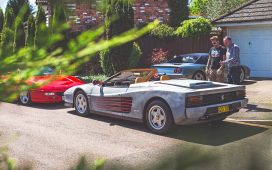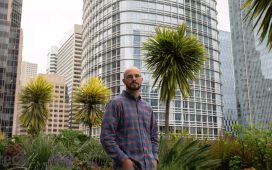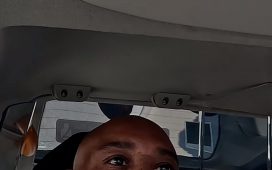The Full Transcript
Daniel Raimi: Hello, and welcome to Resources Radio, a weekly podcast from Resources for the Future. I’m your host, Daniel Raimi. Today, we’re wrapping up our electric vehicle (EV) series, and in a fun twist, I’ve invited my cohost, Kristin Hayes, to bring together the threads from the first three episodes she’s recorded and share lessons from her own EV driving experience.
We’ll talk about what it’s like to own and to drive an EV, whether that’s driving around her hometown in Washington, DC, or a recent road trip that covered almost 1,000 miles. We’ll talk about how much it costs to drive, what the upsides are of EV ownership, and what some of the challenges have been, particularly on that recent road trip. At the end, I’ll ask Kristin, if she were to go back in time, whether she would buy an EV again or would’ve made a different choice. To find out, stay with us.
Kristin Hayes, welcome to Resources Radio on the wrong side of the mic or the right side of the mic. I’m not sure which side of the mic you’re on.
Kristin Hayes: On the other side of the mic, for sure. Definitely the other side. It’s quite an experience. But thank you Daniel. It’s a pleasure to be here, as always.
Daniel Raimi: You’ve interviewed me, so I get to interview you this time and ask you the hard-hitting questions that we’re known for here on Resources Radio. But let’s start with the one we ask everybody. Have you always been interested in environmental issues, or did it start when you started at Resource for the Future (RFF) or in your professional life? I don’t know. Tell us about your environmental backstory.
Kristin Hayes: I’d say I have always been interested in environmental issues. I distinctly recall being the president of the recycling club when I was about 10 years old or something like that. I was very into the idea of, particularly, the waste-management side of things when I was little. I was committed to having various recycling bins around the house. That was definitely my introduction to environmental issues.
But I really enjoyed some of my classes as an undergraduate that were at the intersections of hard science. I’m not sure if I’ve mentioned this here on Resources Radio before, but I studied chemistry, and I took an atmospheric chemistry class that really brought climate change onto my radar for the first time. I really enjoyed that. It just felt like it was a great synergy of real-world impact of the science that I was learning. Then, from there, I never really left that interest in the environment. I did some future study in environmental education and then have been working for environmental-adjacent organizations of various varieties ever since. It’s definitely been a passion for a long time.
Daniel Raimi: That’s cool, and it’s interesting: I remember Richard Newell—until very recently, the president of RFF—whose interest in this topic started with waste management, too. Of course, he’s a New Jersey native, so that might be part of it, as well.
Kristin Hayes: I’m not sure what you mean by that, Daniel, but fair enough.
Daniel Raimi: They have a lot of trash in New Jersey.
Kristin Hayes: That’s what I thought you meant. All right. Let’s just make that explicit.
Daniel Raimi: Okay. Sorry, New Jersey, New Jerseyans, New Jerseyites.
Let’s talk about your experience today. As listeners know, we’ve been doing a series in the last few weeks on electric vehicles. During that series, you talked a little bit about a road trip that you were planning in your new EV. I’m curious: how did it go? First of all, where did you go? Why did you go there? And how did things go with EV?
Kristin Hayes: Yes, it was fantastic. It was fantastic in part because of my destination. I will definitely note that from the outset. I did drive to northeasternish Ohio to see the total eclipse. I was at my family’s house. They have a little house on a little lake in northeastern Ohio that was about 20 miles off the center of the path of totality. So, it was awesome.
But I had a long conversation with my traveling companion about whose car we were going to take. I obviously have the electric vehicle and the other car is an internal combustion engine car. We really debated, “Are we really going to take the EV? Are we really going to do this?” And I finally said, “For me, that’s really one of the points—to see how this goes. To just put it to the test. It’s been great day to day in my life, but what does it look like when I try to take this electric vehicle long distances?”
So, it was a twofold mission: one, see the eclipse; two, road trip in the EV. And I learned a ton. I’m sure we’ll talk more about it, but I definitely learned a lot in the process.
Daniel Raimi: Overall, on a scale of 1 to 10 where 1 was, “Oh my gosh, I can’t believe how bad my EV performed on that trip,” and 10 was like, “It was a dream,” what would you rank it?
Kristin Hayes: Daniel, I’m going to have to give you two different rankings. One for the way out and one for the way back. There are some subtleties here.
On the way out, I’d give it an 8. It was pretty straightforward. I’m not going to give it a 10, because it definitely did take more planning and more time than it would’ve taken in my previous internal combustion engine car. But still, I really did not have a lot of significant challenges. Every time we went looking for a charging station, we found that charging station, it was available to us, it was functional, and I got lulled into thinking, Well, this isn’t that bad. This is a piece of cake. I’ll just take my EV everywhere.
On the way back, I’m going to say it was more like a 6. We definitely ran into some challenges that I’ve heard about as I’ve been reading more about EVs and have now experienced. But overall, it was really very satisfying in both the sense of learning and the sense of understanding where you really need to plan ahead. I’d give it an average of 7.
Daniel Raimi: Okay. Seven. Not bad, not great.
Kristin Hayes: Seven it is. Not bad. Yeah.
Daniel Raimi: Not bad. Okay. Let’s cut a little bit deeper. Tell us more about what was successful and what was a pain or what was a challenge on your trip?
Kristin Hayes: Yeah. First of all, I will note, on the way out to Ohio, we left on the 6th of April, a time of year where it can be quite warm. Certainly in Washington, DC, it was fairly pleasant, but also we’re not fully into spring yet, and so it just happened to be a pretty cold day. Particularly, I had to cross over the mountains in western Maryland and West Virginia to get out to Ohio, and it was cold. There were actually some flurries in the air as we drove through the mountainous parts of the journey.
I will say I’ve read, over this past winter, a number of articles that were coming out about the differences in battery life in the cold. That is real. I can attest—not that anyone really doubted it was real—but I have now lived the experience of getting distinctly poor battery life in the cold.
That happened to be the part of the journey where we were really traveling uphill a lot, of course. We were going into the mountains. Between those two things, I learned, Okay, I’m going to have to be more cautious and really keep an eye on the longevity of the battery that I have, because those two things are working against me at this moment in time.
Now, of course, in reverse on the way back to Washington, DC, as we were coming out of the mountains on a much warmer day—the weather had really changed over the course of those four days—neither one of those things really came into play.
In fact, I ended up with more miles at one point at the end of the trip, a particular leg of the trip, than I had started with, because I was coming downhill. I was coming out of the mountains. It was a very pleasant day where the battery was sort of in its sweet spot in terms of temperature. So, it was fascinating to just see what a difference those things make and just how aware you have to be of some of those impacts before you just bank on a given number of miles that you’re going to get, for example. That was definitely something I noticed.
Another thing we heard a lot in the media ecosystem—we also heard this from Kimathi, one of the previous guests—about infrastructure and how reliable that infrastructure is. Will charging stations always be functioning the way you want them to? As I noted at the beginning, on the way out, everywhere they were, they worked perfectly. And I thought, Oh, what are these people complaining about? This is great.
On the way back, that was not the case at all. I’d say maybe 30 percent of them were not working at any given time. So, I really found myself wondering, Who takes care of these? Whose responsibility is it to get these things up to speed, back to functioning, and how quickly does that happen? I definitely noticed that piece of the puzzle, too.
Maybe just one last thing I’ll say, Daniel, because I feel like I can talk about this forever, but it does take more patience, for sure. You have to stop more frequently. You have to stop for longer periods of time. It turns out, though, that was actually a very pleasant way to road trip compared to just plowing ahead and stopping for 10 minutes and grabbing something at the 7-Eleven and then keeping on going. It was actually really nice to have these little breaks, probably in parts of America that we wouldn’t have seen, in random car dealerships and just lots of interesting parts of America that I don’t think we would’ve seen otherwise. I actually really enjoyed that.
Daniel Raimi: That’s cool. I’ve taken a lot of road trips, and I can’t say that I’ve ever stopped at a car dealership that I found to be an interesting place to visit. But you actually enjoyed your time in the suburban car-dealership ecosystem?
Kristin Hayes: I mean, yes. I’m going to go ahead and say yes. They had great bathrooms—way better than the average gasoline station. We got to just see a little bit more of America and go to Cracker Barrel. It wasn’t the worst, for sure.
Daniel Raimi: All right, great. Well, the next question I want to ask you is about economics. RFF, of course, is largely an economics institution, and I couldn’t help but ask you about the costs of your road trip. Oftentimes, EV advocates will talk about how much cheaper it is to operate an EV. I had always figured that that was obviously true, but I’d never actually done the math. So, I asked you to do the math. Tell us about the cost of your trip and how it might compare to your trip if you were driving a very efficient hybrid, or maybe if you were driving the average American passenger vehicle?
Kristin Hayes: I loved that the math was requested for this exercise, because the beauty of having a system that runs so much on apps and technology is that I do have lots and lots of data, and it’s really fun for me to crunch through that data. I did do that when I got home. I had probably six or seven different charging stops that I could actually use to calculate. I went with a calculation of cost per mile. That’s what I ended up using as my metric. It seemed most straightforward as a comparison, and I had a couple of charges here at home that I was able to calculate before I hit the road, and then a number of stops along the way at various different fast-charging stations across the country—quite a bit of diversity. They ranged from here at home, where my cost per mile was 3.5ish cents; just under 4 cents. Out in the world, they ranged from let’s say 5.5 cents, which was really quite on the low end, to over 10 cents a mile.
What does that compare to? I don’t know. That doesn’t sound like that big a deal, I suppose. Then, I started playing around with, as you said, some of those comparisons to my previous car, which was a hybrid, and then some national average comparisons. Just to put it in context here, the total road trip that we took was about 940 miles, let’s say, and across all of those different stops—my home charging, my fast charging in various parts of the world—I averaged about 8.5 cents per mile over those 940 miles.
Then, I figured out that if I had done it in the Prius, given the average fuel efficiency in the Prius, it actually would’ve been lower. It would’ve been about 7.75 cents per mile. But that’s still considerably higher than the cost of home charging. So, it was really those fast chargers that tipped it over into more expensive territory.
But then still, let’s say it’s a little bit more expensive than what I would’ve paid with my Prius, but for the average passenger vehicle that gets 26 or 28 miles per gallon, that cost per mile is close to 13 cents, 12.66 cents—something like that. It’s definitely cheaper than the average US internal combustion engine vehicle. I’m not totally sure how to interpret that—whether that says home charging is really the best option, whether hybrids are still really cost competitive in that sense—but it was definitely cheaper than the average car.
Daniel Raimi: It makes me think of something that owners of internal combustion engine vehicles don’t think about, which is that the fuel price is the same whether or not you’re getting it close to your home or far from your home, but when you’re in an EV, home charging is considerably cheaper than your road trip–type charging.
Kristin Hayes: Something I’ve thought about, too, is in the total cost of ownership; you have to think about maintenance, as well. I haven’t had to maintain this car yet, but I’m very cognizant that there’s no more oil changes in my future, fewer moving parts. Something that I will be looking for moving forward is that the cost of maintenance really less, as well, in addition to that cost per mile charges.
Daniel Raimi: Right. The cost per mile we were talking about are just fuel costs. They don’t include depreciation or maintenance or anything like that.
Let’s zoom out from the economics for a moment, and I want to ask you about the whole scope of the conversations you’ve had over the last several weeks. You’ve talked with experts on things like driver behavior, you talked about battery technology and its evolution. You talked about electric vehicle chargers. When you look back across the whole series, what parts of those discussions resonate with you the most, now that you’ve had some more time to drive your beloved electric vehicle, which, of course, folks know, is called Vanilla Ice. And I’ll just note that it’s ironic that you named it Ice since it’s not an internal combustion engine vehicle.
Kristin Hayes: Fair enough. Fair enough.
Daniel Raimi: But we’ll just set that aside for now.
Kristin Hayes: I would also like to state for the record that I did not actually name the car Vanilla Ice. That was a name given to the car by small children, which makes me even happier. But, yes.
Daniel Raimi: That is awesome. They didn’t think about calling it Vanilla EV?
Kristin Hayes: I think its other potential name was Shark’s Tooth. So yeah, much more creative than I ever am when it comes to those things, for sure.
It’s a great question, Daniel. I thought a lot about the conversations I’d had. It was actually great. I was really grateful to have recorded the three previous episodes before going on this road trip, so that I had a lot of those lessons to take with me. But to give you just a few specifics, I guess one thing I really thought a lot about was my discussion with Kimathi Boothe about this sense that chargers are really ubiquitous in some places and just nonexistent in others, and can that in fact be true? Can this tension between everywhere and nowhere be true?
I will say this road trip made me feel more in the nonexistent camp, I’m afraid to say. It’s not that we couldn’t find places to charge; for example, one of the places we stopped to charge multiple times was in this giant mall parking lot outside of Columbus, Ohio, and there were eight EV charger slots there. I think there were four fast chargers and four Level 2 chargers. I was super grateful that they were there. It was a wonderful place to be able to stop and spend 45 minutes and do our enjoyable rest stops.
But those eight charger slots were a tiny fraction of the number of cars in this ginormous parking lot. I just found myself wondering what happens if demand for these vehicles is just slightly higher? How is this evolution going to happen between demand for chargers and demand for vehicles? It really felt like we were on the low end of the infrastructure that’s needed. That was something I was definitely aware of.
I thought about my conversation with Micah about battery range, and I think I have this fascination with this idea that maybe there’s something really transformative out there, like solid-state batteries, for example, where suddenly a driver might be able to get 800 miles on a charge. I think that level of change in battery range would in fact be quite profound. But for me, something more incremental, like getting 350 miles instead of 300, really wouldn’t do that much to alleviate any sense of range anxiety. I found myself wondering a lot about incremental change in that range versus more transformative. That was on my mind for sure.
Then, to highlight one from the first episode, I talked a little bit with Sebastian about the world of phone apps that are really instrumental to EV ownership. I’ve discovered that’s just really true. I found that owning the EV really does take a level of comfort with technology that I pretty much have. I’m perfectly fine with technology, but it’s definitely a learning curve.
I found myself thinking a lot about overcoming the learning barriers that some buyers might have. Forget all the other concerns we’ve talked about, but even just the technology-learning barriers, and how do we get rid of that intimidation factor. Maybe that’s something that I’m overblowing. Maybe, as younger generations are buying cars, they’re obviously much more technology-comfortable. The younger the person … They’ve certainly grown up with technology. But I’d be really curious to see if there’s been any survey work or other information that would illuminate whether that technology piece is an issue here.
Daniel Raimi: That’s really interesting, and it segues right into the next question I wanted to ask you, which is about research. Obviously, most of our episodes here on Resources Radio are about research, and when we’re talking with our colleagues at RFF, we’re usually talking about research or budgets, but usually it’s research. Talk to us a little bit about any research ideas that might’ve popped up either in your conversations over the course of this podcast series or on your road trip.
Kristin Hayes: There were many. We do love calls for more research here on Resources Radio, that’s for sure. I had hoped to have a chance to talk with our Transportation Program director, Beia Spiller, before coming on here. Unfortunately, I didn’t quite get to that, so I hope I’m channeling some of the ideas that I know people here have been thinking about, too.
But some of the things that really occurred to me, that I’d love to know more about: I’m going to put this in quotes, but what “optimal deployment,” if you will, of charger infrastructure looks like in various contexts. In my more anxious moments, I was really thinking, oh gosh, we’re going to need chargers pretty much everywhere to support populations that don’t have access to home charging.
But I don’t think the answer can actually be to put chargers everywhere. That just doesn’t seem economically efficient. It’s probably not really necessary, either. So, how many stations do we really need, and where and when and how can we collectively be strategic about these early investments to help make this adoption feel much easier than it is right now—or at least easier than it is right now, but still keeping some of those equity considerations that we talked about in mind so that we’re not just placing them where the cars are being purchased right now? I think there are a ton of questions here about what that optimal deployment and timescale of deployment looks like in a way that gets us where we want to go and builds a comfort level, but doesn’t overinvest or underinvest in certain places. That was hugely on my mind, for sure.
Another thing I found myself wondering about was even faster charging. There really is a difference between a five-minute pit stop at a gasoline station and 45 minutes. At least in Vanilla Ice, it takes about 45 minutes to get back up to a comfortable battery level—not to 100 percent, but to a level that you’d want to get back on the road. I wondered, Is anyone thinking about even faster charging so you really can reduce that charging time to be at least more equivalent to filling up a gasoline tank? I’ll be honest, I’m sure we’re getting into some laws of physics and some safety concerns that I don’t really know anything about, but I did find myself wondering about that. Have we reached the limit of what we can do in terms of charging time or is there a continued amount of innovation that’s happening there that would be worth learning more about?
Oh gosh, the list goes on. I would love to know more about who’s purchasing electric vehicles and whether they also have regular access to an internal combustion engine car. That’s something from a number of conversations I’ve had. Folks with two-car families love the EV for commuting, and they’re very happy with it as a commuter tool where they can drive relatively short distances, but they still have another car for longer journeys. Is that the right answer in terms of trying to get everyone in EVs all the time? That’s probably the third or fourth time that I’ve heard that suggestion. So, I’d love to see who’s buying these EVs. What other kinds of car access do they have? Is this their sole vehicle? How does this pair with, let’s say, rental car companies or car-share companies that might be available for those short-term things where the EV is really your day to day, but you do have access to something else for these longer road trips?
I’d love to see sales data. I’d love to work with some of the folks here at RFF to really parse out the ebbs and flows of purchases. There’s been a lot of reporting on, “Uh-oh, we’ve hit a plateau,” or, “Oh, no, it’s okay.” People are definitely still going to keep purchasing EVs. I’d love to know more about how much the tax credits are making a difference. Just a ton of questions out there.
Daniel Raimi: Things are definitely changing all the time, and some of those questions that you talked about are things that I feel like I’ve heard come up at conferences from folks like Ken Gillingham and Dave Rapson. There’s some work on some of these topics, but you’re right that it’s always changing, and especially things like policy changes we’ve seen in recent years could make a huge difference.
Kristin Hayes: Yeah. Daniel, will you humor me if I call out just one more? Something that occurred to me just this morning. I plugged my own car in last night here at home. I’m incredibly lucky to have that home charger. I want to acknowledge that again, and I found myself thinking, “This is so great to have.”
We’ve talked previously about that being by far the most economical way to charge. So, I actually found myself wondering, Is there some way that I could rent out my home charger to folks? It’s like an Airbnb for chargers or something like that, because I don’t need it all the time. I love having it, but I certainly don’t need it constantly. Would something like that be a possibility, where we could put more low-cost charging options out into the world and maybe start to get at some of those optimal-deployment questions? But would that actually reduce the need for a real ramp-up in public infrastructure charging?
That’s just one thing I’ve been thinking about, too, is how are we going to get creative with some of these solutions? I’m sure people are thinking about this, but it’s definitely been on my mind.
Daniel Raimi: That’s an interesting idea.
So, drumroll please, Kristin. I want to ask you the big question. If you could go back in time and you knew what you know now, would you still buy an EV?
Kristin Hayes: Absolutely. I really would. It’s been super fun. It’s been a chance to just learn a lot of new stuff. Obviously this series has been a chance to learn a lot of new stuff. Certainly, buying the car was fun in that sense, too—just having something to explore. But I do like being a little bit on the vanguard, if you will, and I certainly feel like a solid 7 for a road trip and a 9.5 for day-to-day experience is well worth the repeat purchase. I’ve really enjoyed it. And I will say one other thing: Compared to the Prius, the joy of driving this electric vehicle is real. It’s like a race car in comparison, and I love it. So yeah, absolutely.
Daniel Raimi: That’s awesome. I feel like I just want to highlight that number that you threw out there. We talked about your road-trip experience, which was a 7 overall, but you said your day-to-day driving experience is like 9.5, almost 10?
Kristin Hayes: It’s great. Yeah.
Daniel Raimi: Okay. So that’s the Kristin Hayes perspective, the cutting-edge Kristin Hayes perspective. But when you zoom out, and you think about the country as a whole, and you think about some of these challenges that you’ve learned about and that you’ve observed on your road trip, have you become any more or less optimistic about the pace at which a transition to EVs is going to unfold in the United States over the next 5, 10, 20 years?
Kristin Hayes: Excellent question. I don’t want to end on a downer, but I will say I think I’ve become, if not more pessimistic, at least more realistic about the pace, for sure. I see the situations in which it really works and works really well. We’ve talked about the day-to-day experience being wonderful, but I benefit from that home charger, which makes a big difference. Lots of people won’t have that option, at least not right now.
Then, I’ve seen some of the challenges on these long-distance trips that just require more time and more planning. I wouldn’t be surprised if we really do this in fits and starts, and we don’t get all of those infrastructure investments quite in the right places at the right times.
That being said, I’ve been heartened to read about the ways in which EV production here in the United States is really moving into a number of states. It’s not just a blue-state experience. There’s a lot of investment in EV production in South Carolina, for example. So, I think the markets will continue to grow. The cars are excellent. Right now, the Biden administration is working hard—we could debate this on another podcast—to actually keep lower-cost Chinese electric vehicles out of the US market. Who knows what would happen if that actually changed. It’ll be really interesting to see. I think I’m going to say, “Watch this space” to see how we go over the next few years.
Daniel Raimi: Certainly wherever you look, you can find a mix of positive and negative news on this front. We’re recording today’s episode on April 22, 2024, and just in the last couple of days—
Kristin Hayes: Earth Day.
Daniel Raimi: Yes, even on Earth Day, there’s been really bad news out of Tesla in particular: a huge recall with their Cybertruck and slow sales numbers. Then again, if you look at the macro trends, sales are still going up, and we’re still generally going in the right direction. So, I agree, it’ll be really fascinating to watch over the next few years.
Kristin Hayes: For sure.
Daniel Raimi: Kristin, I’d love to close the show by asking you the same question we ask all of our guests, to recommend something that’s at the top of your literal or your metaphorical reading stack.
Kristin Hayes: I’m going to go with literal, and that is a book called How to Know a Person. It’s by David Brooks, and I found the title very intriguing. I’d like to think that we all feel like we know how to know people, but he’s really making an argument for listening more than talking, which is ironic, given that I’m talking my way through this episode. But he’s arguing for listening more than talking, for really working to ask good questions and to understand different perspectives in the world. He really sells this as a way to both deepen interpersonal relationships, but also to really work through a lot of the political turmoil that’s happening in this country right now, too. So yeah, it’s been wonderful and pretty inspiring.
Daniel Raimi: That sounds really fascinating. Yeah, I’ve loved some of his books in the past, and this sounds like a really good one, too, and also useful for podcast hosts trying to figure out good questions to ask their guests.
Kristin Hayes: Yeah.
Daniel Raimi: Great. Well, Kristin Hayes, this has been really fun. Thank you so much for coming onto the show and sharing your experience. Thank you for putting together this series, which has been really fascinating. I’ve enjoyed listening to all the episodes, and I’m sure our listeners have, too.
Kristin Hayes: Thank you so much, Daniel. It’s been nice to be on the other side. You’re a great host.
Daniel Raimi: I’m doing my best to keep up with you, my friend.
Kristin Hayes: Okay, good. We’ll talk again soon.
Daniel Raimi: You’ve been listening to Resources Radio, a podcast from Resources for the Future, or RFF. If you have a minute, we’d really appreciate you leaving us a rating or a comment on your podcast platform of choice. Also, feel free to send us your suggestions for future episodes.
This podcast is made possible with the generous financial support of our listeners. You can help us continue producing these kinds of discussions on the topics that you care about by making a donation to Resources for the Future online at rff.org/donate.
RFF is an independent, nonprofit research institution in Washington, DC. Our mission is to improve environmental, energy, and natural resource decisions through impartial economic research and policy engagement. The views expressed on this podcast are solely those of the podcast guests and may differ from those of RFF experts, its officers, or its directors. RFF does not take positions on specific legislative proposals.
Resources Radio is produced by Elizabeth Wason with music by me, Daniel Raimi. Join us next week for another episode.

